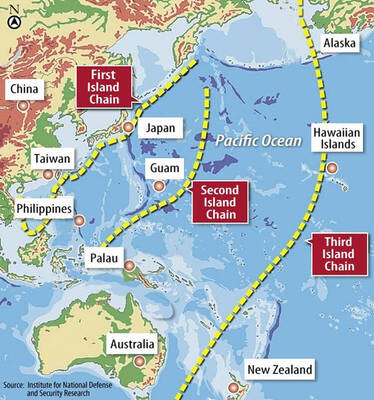A Chinese Nationalist Party (KMT) task force on cross-strait discourse has proposed new guidelines for the construction of stable and peaceful relations across the Taiwan Strait as part of the party’s reform efforts.
The task force, overseen by the KMT’s reform committee, proposed four pillars for the party’s handling of cross-strait relations at yesterday’s meeting of the committee: upholding the Republic of China’s national sovereignty; safeguarding freedom, democracy and human rights; prioritizing the safety of Taiwan; and creating win-win cross-strait relations.
In its presentation, the task force proposed that the “1992 consensus” should be viewed as “a historical description of past cross-strait interaction.”

Photo: Chien Jung-fong, Taipei Times
The so-called “1992 consensus” — a term that former Mainland Affairs Council chairman Su Chi (蘇起) in 2006 admitted making up in 2000 — refers to a tacit understanding between the KMT and the Chinese Communist Party (CCP) that both sides acknowledge that there is “one China,” with each side having its own interpretation of what “China” means.
Although past KMT administrations had deemed the “1992 consensus” an important basis for seeking common ground in cross-strait interaction, the term has been marred by President Tsai Ing-wen’s (蔡英文) administration, the task force said.
Chinese President Xi Jinping’s (習近平) speech last year marking the anniversary of the 1979 “message to compatriots in Taiwan” also generated strong opposition to the term among Taiwanese, as Xi urged them to accept Beijing’s “one country, two systems” formula based on his claim that it was part of the “1992 consensus,” it added.
Tensions across the Taiwan Strait have not been higher since Beijing launched missile tests in 1996, as it attempted to influence Taiwan’s first direct presidential election that year, it said.
The task force recommended that the KMT, as a party with a strong sense of responsibility, use the guidelines to work toward stable cross-strait relations, saying that it should push for a legal mechanism with oversight powers that would allow cross-strait negotiations to be as open and transparent as possible.
Legislation should be drafted to regulate interaction between officials across the Strait so that exchanges based on inappropriate interests end, it said.
The KMT would continue to promote long-term economic and trade relations across the Strait, but would ensure that the fruits of such economic development benefit the majority of Taiwanese, the task force said.
“We will do everything we can for peace, but we will never kneel down for it,” the task force said. “The KMT will never accept any option that alters the national sovereignty of the Republic of China — therefore ‘one country, two systems’ is not an option for Taiwanese.”
“We also know that Taiwanese independence is unfeasible. Cutting off Zhonghua (中華) symbols and slashing the inheritance of the minkuo (民國) would not only create rifts in Taiwanese society, but also block the support that it receives from the international community, which it needs very much,” it added.
The four guidelines are the keys to resolving long-time opposition between Taiwan and China, it said.
Following the presentation, KMT Chairman Johnny Chiang (江啟臣) said that the “change toward the ‘1992 consensus’ was not introduced by the KMT, but by Beijing and the Democratic Progressive Party (DPP), who have led the Taiwanese public to misunderstand and distrust the term.”
KMT members should be open-minded toward the variety of political views held by different generations of Taiwanese, he added.
Like the DPP, the KMT stands for national sovereignty, democracy and human rights, Chiang said, adding that he hopes the four guidelines can take the party to a better place on its way to reform.

The US government has signed defense cooperation agreements with Japan and the Philippines to boost the deterrence capabilities of countries in the first island chain, a report by the National Security Bureau (NSB) showed. The main countries on the first island chain include the two nations and Taiwan. The bureau is to present the report at a meeting of the legislature’s Foreign Affairs and National Defense Committee tomorrow. The US military has deployed Typhon missile systems to Japan’s Yamaguchi Prefecture and Zambales province in the Philippines during their joint military exercises. It has also installed NMESIS anti-ship systems in Japan’s Okinawa

‘WIN-WIN’: The Philippines, and central and eastern European countries are important potential drone cooperation partners, Minister of Foreign Affairs Lin Chia-lung said Minister of Foreign Affairs Lin Chia-lung (林佳龍) in an interview published yesterday confirmed that there are joint ventures between Taiwan and Poland in the drone industry. Lin made the remark in an exclusive interview with the Chinese-language Liberty Times (the Taipei Times’ sister paper). The government-backed Taiwan Excellence Drone International Business Opportunities Alliance and the Polish Chamber of Unmanned Systems on Wednesday last week signed a memorandum of understanding in Poland to develop a “non-China” supply chain for drones and work together on key technologies. Asked if Taiwan prioritized Poland among central and eastern European countries in drone collaboration, Lin

The Chien Feng IV (勁蜂, Mighty Hornet) loitering munition is on track to enter flight tests next month in connection with potential adoption by Taiwanese and US armed forces, a government source said yesterday. The kamikaze drone, which boasts a range of 1,000km, debuted at the Taipei Aerospace and Defense Technology Exhibition in September, the official said on condition of anonymity. The Chungshan Institute of Science and Technology and US-based Kratos Defense jointly developed the platform by leveraging the engine and airframe of the latter’s MQM-178 Firejet target drone, they said. The uncrewed aerial vehicle is designed to utilize an artificial intelligence computer

Renewed border fighting between Thailand and Cambodia showed no signs of abating yesterday, leaving hundreds of thousands of displaced people in both countries living in strained conditions as more flooded into temporary shelters. Reporters on the Thai side of the border heard sounds of outgoing, indirect fire yesterday. About 400,000 people have been evacuated from affected areas in Thailand and about 700 schools closed while fighting was ongoing in four border provinces, said Thai Rear Admiral Surasant Kongsiri, a spokesman for the military. Cambodia evacuated more than 127,000 villagers and closed hundreds of schools, the Thai Ministry of Defense said. Thailand’s military announced that